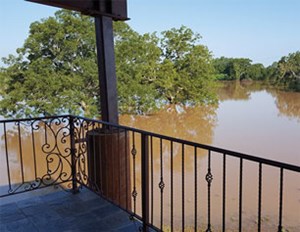First Oil
Last month’s original topic was pre-empted by our tropical nemesis, Hurricane Harvey, so now we pick up the subject again. Back on July 25, Philippe Charlez, senior technical advisor at TOTAL Exploration & Production, spoke at a URTeC luncheon about “Shale Production Resilience & Flexibility: Causes, Risks and Opportunities,” noting that shale plays had nearly doubled U.S. total liquids production, from 6.5 MMbpd in 2006 to 12.7 MMbpd in 2015.
Shale revolution components. Charlez has classified the factors supporting and facilitating U.S. shales into four “pillars,” three “champions,” and two “specificities.” The first pillar is “knowledge of surface,” because the U.S. has drilled 4 million wells since the beginning of the 20th Century, and thus has that great accumulated experience. A second pillar is “an open market of oil and gas services,” which Charlez says allows the presence of many drilling and fracing companies that have built-up expertise. The third pillar is “political support,” whereby the U.S. government has generally allowed the shale sector to become strong, ever since the early 2000s. The fourth pillar is “subsurface belongs to owners.” This, he says, has allowed operators to accumulate, and work on, large amounts of leased acreage.
When Charlez mentions three “champions,” he is referring to the Permian basin, and the Eagle Ford and Bakken shales, as the three plays that primarily have led the way in establishing and growing shale oil production. And when he speaks of “specificities,” he is referring to “resilience”and “flexibility,” two traits that he says highlight U.S. shale output.
Within “resilience,” Charlez says there are three factors or components. “Critical rig count” is the number of rigs required to maintain a production plateau. “Operational performance” says that the better the performance by operators, “the quicker the well portfolio is fed.” The final factor, “reserves per well,” refers to working to improve ultimate recovery per well.
Meanwhile, “flexibility” has four components, one of which is subsurface ownership, allowing flexible markets and quick decisions. A second item is “light means,” referring to operators’ ability to stop and start activity quickly, as opposed to projects with long lead times. The third component is DUCs—when activity is high, the number of DUCs increases, says Charlez, as a result of stressed fracing activity. And when activity is low, the number of DUCs stabilizes and begins to reduce. The fourth item is “flexibility of workforce,” whereby the number of people available to work in shale plays directly relates to oil price. Charlez cited a few more minor factors, but you get the picture.

Further Harvey observations. In August, our company had several employees and their families, whose homes were flooded by the irascible Hurricane/Tropical Storm Harvey. In addition to those folks, our contributing editor for exploration, and monthly columnist, Bill Head, and his wife, also were affected by Harvey.
Mind you, their property, about a mile from the Brazos River, and about 40 mi west/southwest of Houston, was flooded just last year by the Memorial Day storms. The heavy rain sent the Brazos to 5 ft above its previous record level. A barn and two trucks were lost, and a second house (besides the main house) on the property would need to be totally rebuilt.
Fast-forward to August 2017 and Harvey. About 1 in. of water got into the eastern part of the main house during the storm, and then 1 in. entered the west side, as the storm moved north. As Bill says so succinctly, “What can you expect, when 50 in. of rain attack a structure for days at 60 mph?” He notes that a mighty wind began blowing on the river, from northeast to southwest. This caused the river to stop rising “at exactly my foundation. When the river started going down, the wind stopped. We remain speechless.” Again, the barn had 3+ ft of water in it, but the main house was largely spared, although it was a close call. ![]()



